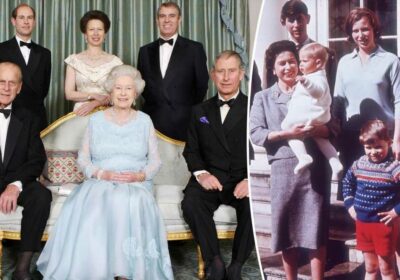Queen Elizabeth as a mother: Inside her ‘devoted,’ yet ‘old-fashioned’ parenting

More On:
queen elizabeth II
Queen had ‘incredible aura when she entered the room,’ says royal photographer
Queen Elizabeth’s iconic jewelry, crowns and tiaras — and who will inherit them
Meghan Markle’s controversial podcast, Fallon appearance put on hold after Queen death
Queen Elizabeth’s life in video: Her 70 years on the throne before death at 96
Queen Elizabeth II held many titles over the course of her 70 years on the throne, but the one of “mother” was often overshadowed by her duty to the crown.
Royal expert Robert Hardman describes the late Queen as a “devoted” — albeit “old-fashioned” — mother to her four children, whom she shared with Prince Philip.
“I think there’s a tendency among some people to sort of apply the norms of modern parenting to the way she brought up her children,” the author of “Queen of Our Times: The Life of Elizabeth II” explained to Page Six of parenting criticism the monarch received over the years.
He went on, telling us that though Elizabeth would leave eldest son Prince Charles and his sister, Princess Anne, for long stretches, her absence was considered normal at the time.
“This was a wartime generation of people who had been separated from their families. Not for a few weeks or months. In many cases for six years,” he said, adding that in post-war Britain children who had both parents “were considered quite lucky.”
“A lot of children were missing at least one,” he continued.
Charles — who ascended the throne on Sept. 8 when his mother passed away at age 96 — was born on Nov. 14, 1948. By all accounts, Elizabeth was besotted with her newborn.
According to Sally Bedell Smith’s biography, “Elizabeth The Queen,” Her Majesty marveled to her cousin Lady Mary Cambridge about Charles’ “fine, long fingers” and breastfed him for two months until she came down with a bout of measles.
Nearly a year later, Philip — then a naval officer — was posted to Malta and Elizabeth was advised that the European isle wasn’t suitable for the infant prince.
“Elizabeth could have stayed in London with her son, but she decided instead to spend as much time as possible with her husband,” Smith wrote. “She had been accustomed to long parental absences while she was growing up, so her decision to leave Charles wouldn’t have raised eyebrows.
“She had expert nannies in charge, not to mention her own parents, who were eager to keep their grandson company.”
Philip and Elizabeth spent Christmas in Malta while Charles stayed with his grandparents, King George VI and Queen Elizabeth the Queen Mother, at Sandringham Castle in the UK.
At the end of December, she flew back to England but stopped first for several days in London, with a quick detour to Hurst Park to see one of her horses win a race. After that brief equine interlude, she was reunited with Charles after five weeks apart.
Another example of how the Queen’s cold relationship with Charles was commended by the public came shortly after his third birthday.
The young prince greeted his parents — along with his grandmother and aunt Princess Margaret — at a train station after they returned from a US visit. While she hadn’t seen her son for over a month, Elizabeth rushed to kiss her mother but “simply leaned down and gave [Charles] a peck on the top of his head before turning to kiss Margaret,” Smith wrote.
“Britain’s heiress presumptive puts her duty first,” a newsreel announcer said at the time. “Motherly love must await the privacy of Clarence House.”
Charles was 3 years old when 27-year-old Elizabeth suddenly became the Queen of the United Kingdom and the other Commonwealth realms in February 1952. Anne, who was born in August 1950, was just 18 months old at the time.
Smith wrote that the children’s lives were “spent mainly in the six-room nursery complex on the second floor of Buckingham Palace.”
On weekdays, according to Smith, Charles and Anne would come downstairs after breakfast for a brief playtime with their parents and did not see them again until the end of the day when they would have a “final romp.”
The Queen, however, did do away with one archaic practice of the crown, which required formal bows from her children when they entered a room she was in.
The monarch also moved her weekly meeting with the Prime Minister from 5:30 p.m. to 6:30 p.m. — a change from her father’s schedule — in order to spend time with her children.
Charles’ friends who spoke to Jonathan Dimbleby for an authorized biography in 1992 said the now-king had a lonely childhood with emotionally distant parents.
Friends who spoke with Charles’ permission described the Queen as “not indifferent so much as detached.”
By the time Prince Andrew was born in February 1960, the Queen was settled and much more confident in her position.
She had always dreamed of a large family but had postponed it because she wanted “to concentrate on establishing herself as an effective monarch,” Smith wrote.
And with the arrival of Prince Edward four years later in March 1964, the family was complete.
“The Queen became a more relaxed and consistently engaged mother with her second set of children,” Smith noted. “Some critics have questioned whether she indulged Andrew and Edward too much, making up for not having spent more time with her older children.”
“She was much closer” with her youngest sons, Andrew and Edward, a royal expert explained.
Popperfoto via Getty Images
“She was much closer” with her youngest sons, Andrew and Edward, a royal expert explained.
PA Images via Getty Images
Lisa Rinna vows to speak her 'truth' at 'RHOBH' reunion
View Slideshow
Source: Read Full Article










